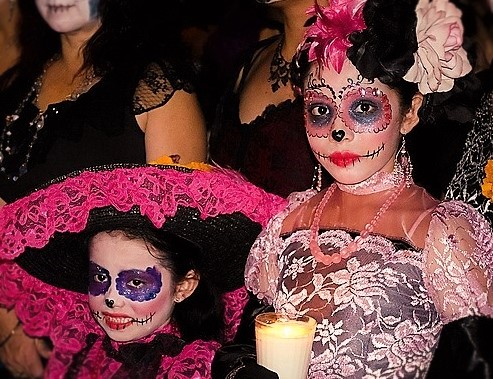An Ofrenda is a traditional food placed at an altar in churches and homes to commemorate the departed on El Dia de los Muertos, which takes place annually on the first 2 days in November. Celebrated in many Latin American cultures, El Dia de los Muertos originated in Mexico combining the minor feast days of the Catholic calendar (All Saints and All Souls Days), aspects of Spanish traditions as brought to Mexico by the conquistadores, and Aztec rituals of the indigenous people of the region.
Typified by symbols of the dead in skeletons and skulls (calacas and Calaveras), painted with traditional decorative motifs and flowers and which appear everywhere during the holiday: in candied sweets and calavers de azucar (sugar molded skulls), as parade masks, and as dolls and figurines. Whimsical depictions of Calacas may be of animals and people alike, usually going about doing whatever they would have done in more corporeal days, but always portrayed as enjoying life, often in fancy clothes and amusing situations and thus they are symbolically included in the life of the community.
El Dia de los Muertos is a collective recognition of the cycle of life; that death is but one of many necessary transitions in life. In honor of the dead, special foods are prepared to entice the departed to return from their rest and celebrate. The food is left at the altars in remembrance and then eaten in celebration during which there are gatherings and community activities. The calacas and calaveras are depicted in candies, candles, on masks, painted on faces, and in effigy or costumes worn by revelers, and skulls formed of sugar. Traditional foods include candied pumpkin steeped in piloncillo sugar and allowed to harden, pan de mueurtos, special round-shaped breads with sugary toppings and designs of crossed bones atop, tamales, mole negro, atole-a thick, sweet, drink of corn flavored with cinnamon, and hot chocolate.
